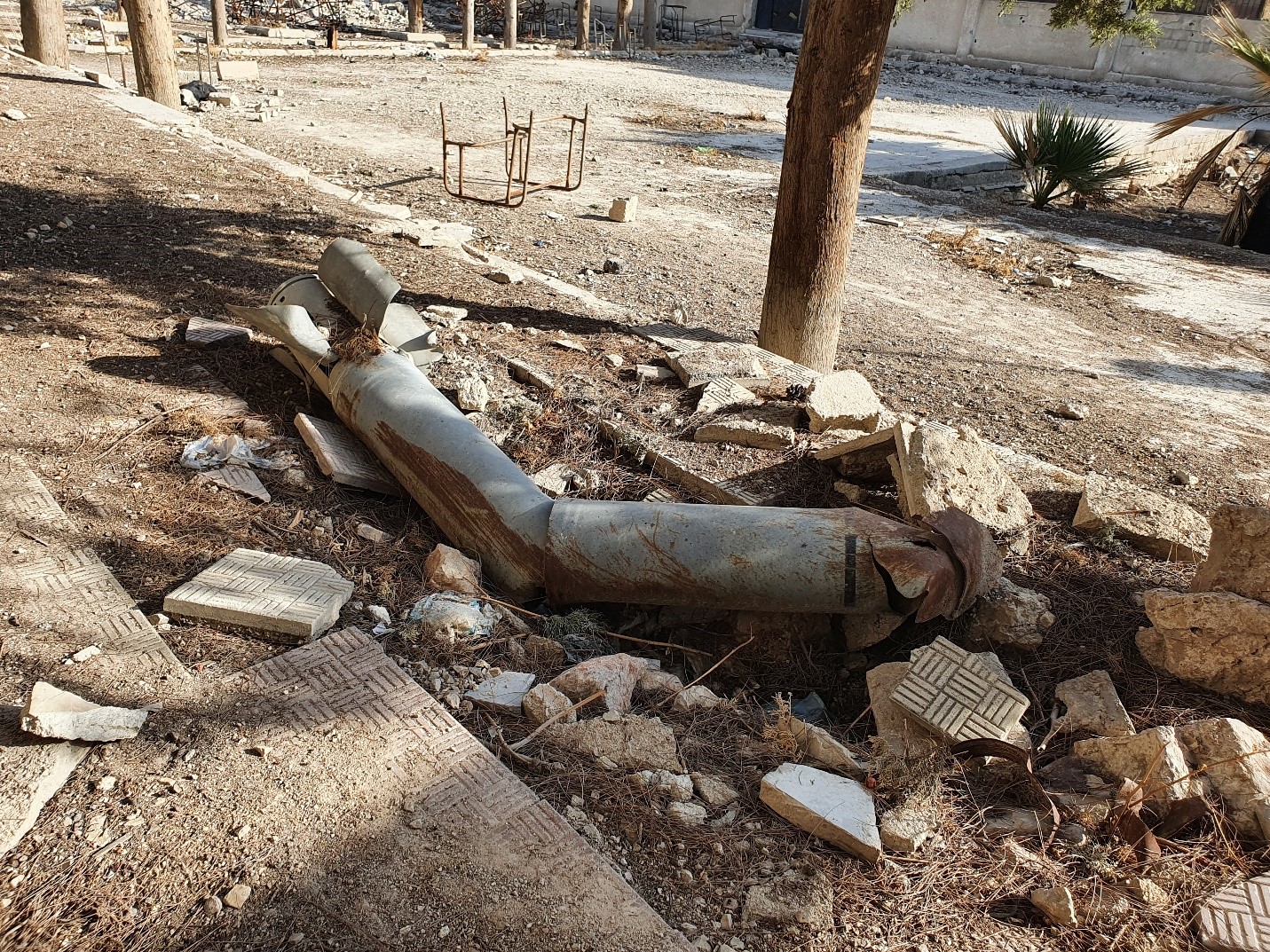Syria: One in two people at risk from explosive ordnance contamination, says new report
Press Release | 11th May 2022, 09:00
Press Release | 11th May 2022, 09:00
After 11 years of war and the intensive use of explosive weapons in Syria, up to 300,000 items of explosive ordnance have failed to detonate. Humanity & Inclusion, in collaboration with the Syria Mine Action Area of Responsibility, publishes on 11 May a new report on the extreme level of contamination in Syria.
One in two people in Syria are at risk from explosive ordnance. This amounts to over 10 million people – about the size of the population of Portugal or Sweden. As clearance will be key before any reconstruction can even be considered, Humanity & Inclusion is calling on donors to significantly support demining operations and also risk education awareness campaigns to protect people from further accidents. Humanity & Inclusion is also calling for immediate and concrete assistance to survivors.

Explosive ordnance in a school in an area in Syria emerging from active conflict - © DR
The report highlights the extent of explosive ordnance contamination in Syria and its devastating impact on people, vital infrastructure and the provision of humanitarian assistance, as well as the need for crucial mine clearance activities and victim assistance.
In 2020, there were an average of 76 recorded explosive ordnance accidents per day in Syria, equivalent to one every 20 minutes.
"The threat of explosive ordnance is everywhere in Syria,” says George Graham, Executive Director of Humanity & Inclusion UK. “Risk education campaigns are urgently needed to prevent accidents: Over three-quarters of casualties were unaware that the location where their accident occurred was dangerous, and another three-quarters of them went to the location several times before the accident. There is an immediate need to raise awareness about the danger: to provide clear and accessible information on the location and type of contamination and what people need to do to protect themselves.”
Syria is the country recording the largest number of explosive ordnance casualties in the world. The majority of recorded accidents are in northwest Syria.
United Nations Mine Action Service (UNMAS) coordinated casualty reports and recorded 12,345 explosive ordnance casualties in Syria between 2013 and 2020, resulting in 4,389 deaths and 7,956 injuries.
In 2020, the Landmine Monitor recorded the highest number of annual casualties (2,729) for Syria since its reporting began in 1999. The actual number of casualties is certainly much higher given limitations in data collection. For example, Action on Armed Violence recorded 77,535 explosive ordnance casualties in Syria between 2011 and 2020.
In 2022, extensive bombing and shelling continues in northwest and northeast Syria, in addition to widespread violence across the country through missile and drone strikes, use of vehicle-based improvised explosive devices, and small firearms and light weapons.
Contamination is incredibly diverse and massive as the whole range of explosive weapons has been used in Syria: Improvised explosive devices, landmines, including improvised mines, aerial bombs, mortars, etc. have been widely used during the 11-year conflict.
All of Syria is contaminated. Operations to identify the extent of the contamination and safely clear the land for effective use will take decades.
“Syria will require long and complex clearance operations before any reconstruction can even be considered. The contamination is so vast and diverse that clearance experts have had to adapt and invent new ways to work,” says George Graham. “We are pretty sure that in 2050, in the middle of the century, clearance operations will still be ongoing to free the country from the threat of mines and other explosive remnants of war."
The contamination includes agricultural land, disrupting the traditional local economy and increasing the danger to agricultural workers who return to unsafe fields to make a living that is vital for them and their families. Further, urban areas are highly contaminated which both puts people in danger and prevents humanitarian organizations implementing much-needed activities such as the rehabilitation of homes, schools and health centers.
Methodology : The report “Explosive ordnance in Syria: impact and required action” relies on available data from a range of sources, including, casualty reports, community impact surveys, UN-coordinated multi-sectoral needs assessments, NGO surveys, and insight from humanitarian field staff and affected persons. This includes engagement with over 20 international humanitarian international organizations in Syria, 9 of which focus on humanitarian mine action, between August 2021 and March 2022.
Mira Adam
Sr. Media Officer
[email protected]
Tel: +1 (202) 855-0301
Elizabeth J. Sellers
e[email protected]
Tel: +1 (270) 847-3443
Get the latest news about Humanity & Inclusion's work delivered straight to your inbox.
ABOUT US
Humanity & Inclusion U.S.
8757 Georgia Avenue
Suite 420
Silver Spring, MD 20910
MORE INFORMATION
Humanity & Inclusion is a nonprofit 501(c)(3) organization (EIN/tax ID number: 55-0914744). Contributions are fully tax-deductible to the extent allowable by law. CFC #51472
None of the funds donated through this website will benefit activities in the following countries: Cuba, Iran, North Korea, the Crimea Region, or Syria. Humanity & Inclusion does not have programs in all of these countries.